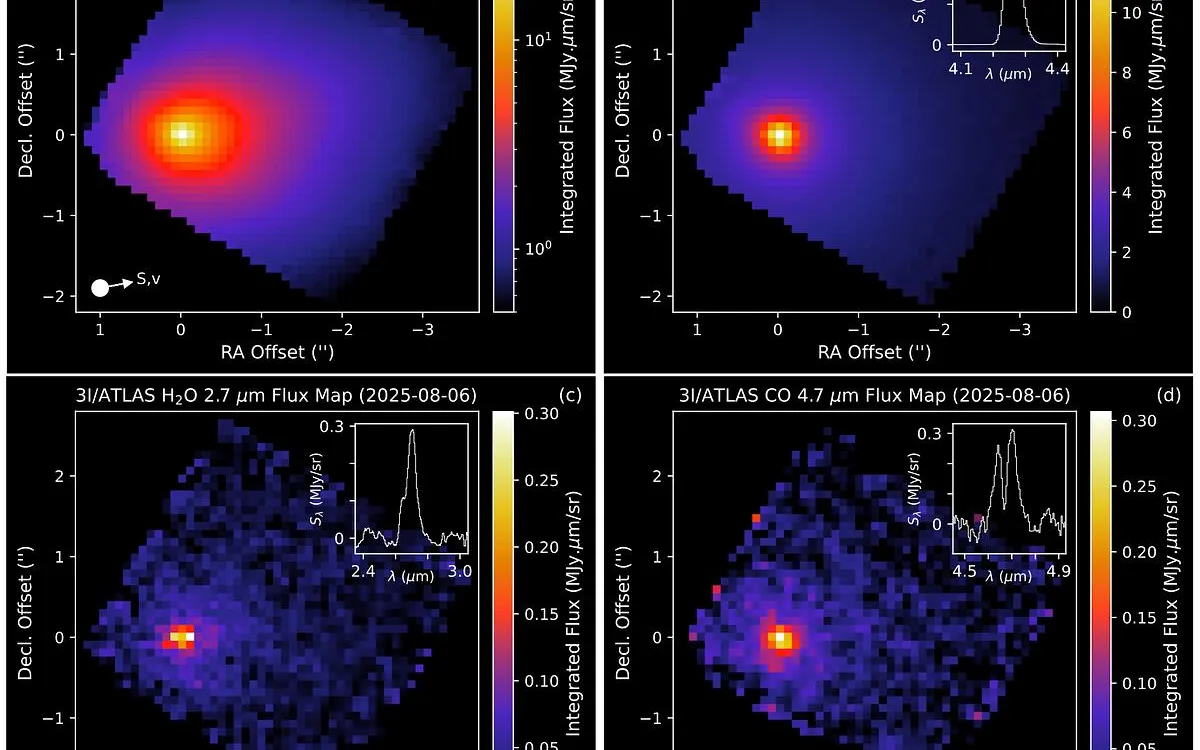
Just moments before my flight to Copenhagen took off from Boston’s Logan Airport, I received an email containing the latest research paper detailing the first data from the Webb Telescope, dated August 6, 2025, regarding the interstellar comet 3I/ATLAS. The 15-minute wait for the onboard WiFi to connect felt like an eternity, but the anticipation was undoubtedly worth it. The stunning data from the 6.5-meter infrared telescope showcased unprecedented spectral sensitivity, confirming the presence of a carbon dioxide (CO2) gas plume surrounding 3I/ATLAS while indicating significantly lower levels of water (H2O) and carbon monoxide (CO), as previously reported by the SPHEREx space observatory team.
The Webb Telescope offers remarkable spectral and spatial resolution, surpassing the capabilities of SPHEREx, which managed to map the spherically symmetric CO2 plume located over 348,000 kilometers from 3I/ATLAS. Notably, 3I/ATLAS does not exhibit a typical cometary tail, as indicated by higher resolution images from the Hubble Space Telescope. This absence of a tail suggests that 3I/ATLAS does not release a significant amount of dust particles comparable in size to the wavelength of sunlight, approximately 0.5 micrometers. Thus, the reflected sunlight observed originates directly from the surface of 3I/ATLAS, leading to a diameter estimation of up to 46 kilometers based on an albedo of 5%, as inferred from SPHEREx data.
The infrared spectroscopy conducted on 3I/ATLAS at a heliocentric distance of 3.32 Earth-Sun separations was performed using the NIRSpec instrument onboard the Webb telescope. Spectral images captured at wavelengths between 0.6 and 5.3 micrometers revealed a CO2-dominated coma exhibiting enhanced outgassing towards the Sun, alongside much lower levels of H2O, CO, water ice, and dust. The derived ratio of CO2 to H2O molecules stands at an impressive 8, marking it as one of the highest ratios ever observed. This data suggests that 3I/ATLAS has an intrinsically CO2-rich nucleus, which raises questions given the surprisingly low abundance of H2O vapor at such a distance from the Sun.
The spectral analysis of 3I/ATLAS indicates mass loss rates of 130 kilograms per second for CO2, 6.6 kilograms per second for H2O, and 14 kilograms per second for CO. Notably, the H2O mass loss rate is merely 5% of the CO2 output, which is 16 times more extreme than what one would expect from a typical comet at a similar distance from the Sun. The SPHEREx observations at a wavelength of 1 micrometer suggest that the nucleus of 3I/ATLAS has a diameter of 46 kilometers, which is a million times larger than the previous interstellar comet, 2I/Borisov. This significant mass difference is unexpected, as it implies that several objects of comparable size to 2I/Borisov should have been discovered prior to 3I/ATLAS.
The Webb telescope's image captured at a wavelength of 1.2 micrometers shows no cometary tail trailing behind 3I/ATLAS. Instead, the glow surrounding the comet may originate from the reflection of sunlight off fragments of CO2 ice that 3I/ATLAS sheds, rather than from dust. These icy fragments evaporate when exposed to sunlight, forming the extended spherically symmetric CO2 cloud around the comet. The total CO2 mass loss corresponds to the ablation of a millimeter-thick layer from the surface of a 46-kilometer object over a few years, indicating that a thin outer layer is sufficient to sustain the observed gas cloud.
Interestingly, the high CO2 to H2O ratio in 3I/ATLAS is intriguing, as only one previous comet, C/2016 R2, has exhibited a similarly extreme ratio, although its features, including a clear cometary tail, differ significantly from those of 3I/ATLAS. The Webb team proposes that this unusual gas plume composition may result from high reflectance or reduced heat penetration through the comet's surface. Adjusting the albedo from 5% to a maximum of 100% alters the estimated diameter from 46 kilometers down to 10 kilometers, which still presents a challenge concerning the availability of rocky material in interstellar space.
To reconcile the discrepancy between the expected mass of rocks in interstellar space and the surprising discovery of a large object like 3I/ATLAS, it is proposed that this comet did not originate from a random population of rocks but rather followed a trajectory specifically designed to enter the inner Solar System. This theory aligns with its retrograde trajectory, which coincides with the orbital plane of the planets around the Sun—a statistical coincidence of just 1 in 500. As I made my way to the Niels Bohr Institute in Copenhagen, I was pleased to find a new preprint advocating the search for technological signatures from interstellar objects. This ongoing research continues to spark discussions and debates within the scientific community, underscoring the importance of collaboration and different perspectives in advancing our understanding of these cosmic phenomena.
In summary, the findings regarding 3I/ATLAS provide an unprecedented opportunity to explore the characteristics of interstellar comets and enhance our knowledge of the materials that make up our universe.